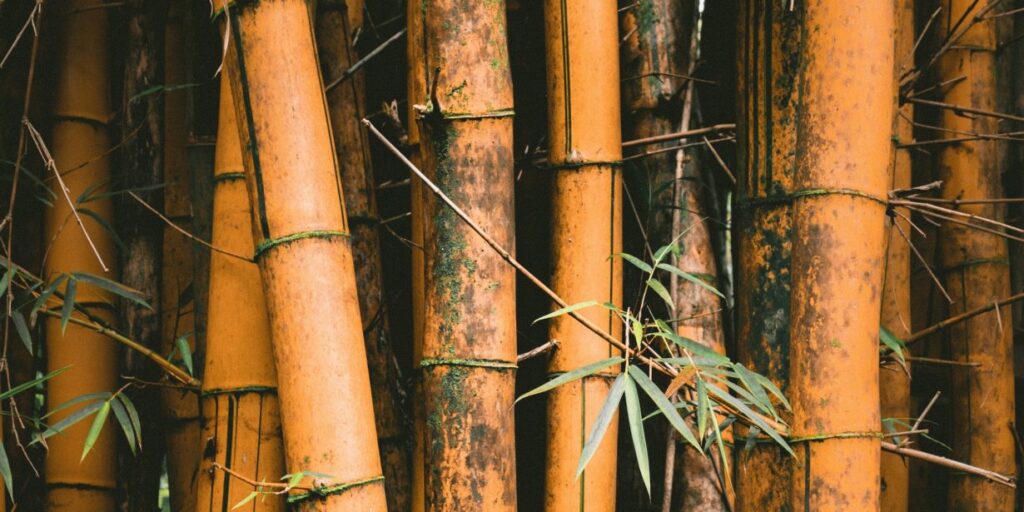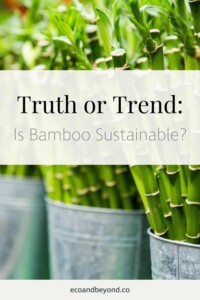I recently switched my plastic toothbrush for one made from bamboo. Now, I’m wondering how far I should go.
What else should I buy that’s made from bamboo? Clothing, utensils, toilet paper? Should I choose bamboo instead of cotton, metal and hardwood, as I do for an alternative to plastic?
Bamboo seems to be paving the way as an eco friendly material, but is bamboo sustainable in all its forms? Even when it’s produced in mass quantities? Or when it’s shipped over from China? Is bamboo eco friendly? Or have I been tricked into the latest greenwashing trend?
Let’s take a closer look into the realities of bamboo sustainability.
What Is Bamboo?
Bamboo is a fast growing and a naturally renewable tree-like grass. It requires little maintenance to farm as it doesn’t need any pesticides or herbicides and very little water to grow.
There are over 1,200 different species of bamboo in existence and most are highly adaptable, particularly in high humidity regions.
Bamboo is able to grow in Southeast Asia, Africa, Latin America, and in the southern regions of the USA. Certain varieties can also grow in colder climates like the UK and Northern America.
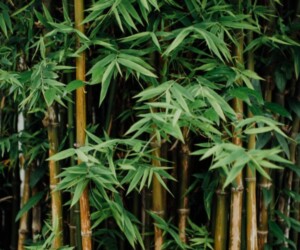
In sustainability circles, bamboo is often thought of as a raw ingredient for clothing and homewares. But bamboo is also a common food source in some parts of the world. It’s not only pandas consuming bamboo in their diet.
Humans have been eating bamboo shoots for thousands of years. Often seen in Asian dishes, bamboo shoots are low in fat and calories and provide a good source of fiber and potassium.
If you’ve ever travelled to South-East Asia you’ll likely have seen bamboo used extensively in the construction industry. Bamboo is commonly used as scaffolding, upright props, and even to build huts and houses.
This is because bamboo is super strong; even stronger than steel! The tensile strength of steel is 23,000 PSI, while the tensile strength of bamboo is 28,000 PSI. Seems crazy, right?
From all this it seems like bamboo might be a super plant … but is it as good for the environment as we might think?
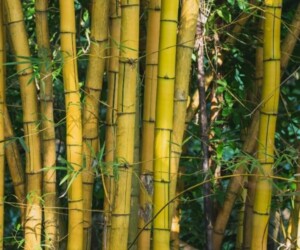
When harvested bamboo regrows from its own root system, it doesn’t need to be planted again. Not only is this great from a naturally renewable perspective, but this also means that the soil and roots aren’t disturbed which is great for soil health.
While the bamboo plant only has shallow roots, they develop to create a fibrous network underground which helps to hold the soil together. By not disturbing the roots and soil between harvests, the soil and the micro-environment beneath the surface continue to develop and improve.
Soil improvement helps with water absorption, as well as aiding in the prevention of soil erosion. Many areas where bamboo is grown are subject to heavy rain and monsoons during the wet season, and improved soil and healthy roots helps to minimise landslides.
Despite all these benefits there is one significant downside to bamboo production.
This biggest problem with bamboo is the way that it is typically farmed. Due to increasing popularity, large areas of land are being cleared to be planted with bamboo. This can lead to the displacement of wildlife and a decrease in the biodiversity of existing ecosystems.
When bamboo is planted as a crop it’s also often done so as a monoculture. This means only bamboo is planted and all other varieties are removed.
Monocultures create problems for fungi, bacteria, insects and other smaller animals who rely on a diverse ecosystem for nutrition and habitat.
This situation applies to any monoculture, not just bamboo. Similar concerns are raised over fields of avocado trees in South America, forests of eucalyptus trees in Portugal and plains of corn and soya in North America.
Is Bamboo Really Eco Friendly?
Currently, the only commercial scale production of bamboo takes place in China. This means the majority of bamboo products in the UK and the US have been shipped from across the globe.
Regardless of bamboo’s eco credentials, the distance a product has to travel greatly influences its carbon footprint.
Also, China has very few agricultural or environmental standards in place. So this is problematic for other reasons too.
So far, it’s proven difficult to measure how Chinese bamboo is grown and harvested. It’s likely that farmers do use chemical pesticides and fertilisers on their crops. This is to increase yields and income, regardless of the fact that bamboo doesn’t need chemical help to grow at a natural rate.
Meanwhile, the high-demand for bamboo, within China and globally, can negatively impact ecosystems.
Farmers may cut down natural forests to make way for bamboo plantations. This destroys the natural habitat of already vulnerable wildlife such as pandas.
WHEN IS BAMBOO SUSTAINABLE?
Bamboo is an incredibly strong yet lightweight material. Especially when compared to wood and steel. In Asia, it’s used in place of steel for the construction of buildings and roads or to reinforce concrete.
As it’s technically a grass, not a tree, there are no weak points along its length. This makes it stronger and more durable than even the toughest hardwoods.
Bamboo also grows much faster than its hardwood and softwood equivalents. As such, it can be harvested every three to seven years. Some timber is only harvested when trees are around 30-50 years old!
Producing bamboo also takes less energy and other resources compared to wood or steel.
Undoubtedly, if we’re living sustainably, bamboo ticks a box. It’s a more sustainable and hard wearing alternative for furniture, flooring and many household items. But does this sustainability apply to all bamboo products?
Are Bamboo Products Sustainable?
Due to bamboo’s versatility it’s being used in an increasingly wide range of products.
We can find bamboo coffee cups and bamboo alternatives to plastic straws. Plus clothing, flooring, furniture and of course: toothbrushes (where this story started…).
Moulded bamboo is also an eco friendly alternative for plastic kitchen utensils and tableware. As long as it’s free from melamine, which is considered toxic by many.
But as with anything green, the answer to the question “is bamboo sustainable?” isn’t clear cut or straightforward.
Here’s a few things that you might want to consider when investigating whether a particular bamboo product is sustainable:
- Where is the item coming from, and how is it being shipped from the source location?
- What processing is required to make the product? Consider the energy and water consumed during the process.
- Have any nasty chemicals been used in production of the product? Have other additives been used that negate the benefits of using bamboo as a raw ingredient?
- Is there an alternative product that is just as sustainable but perhaps not as eco-trendy?
All too often it’s difficult to get answers to these questions because the supply chain isn’t always particularly transparent. Let’s dive into some of the major types of bamboo products and consider their sustainability.
IS BAMBOO FABRIC SUSTAINABLE?
On the surface, bamboo looks like a sustainable solution for the textile industry. But its use as a fabric is actually where this grass falls short.
There’s a good reason why Global Organic Textile Standards don’t give certification to bamboo textiles. Not even if they’ve been produced with organically grown bamboo.
Turning rough bamboo grass and shoots into a usable fabric is not an easy feat. It requires an intensive and chemical heavy process to produce the fabric.
In industrial textile production, cellulose-heavy bamboo pulp is dissolved in a chemical solution. It’s then pushed through a spinneret to produce a yarn which is chemically solidified.
Once the yarn has been produced, it’s often treated with dyes, bleaches or formaldehyde. The end product is a rayon fabric which is far from natural or organic.
The same argument can be applied to the production of cotton. Cotton is often treated using a chemical process. But unlike bamboo, it’s possible to buy Fairtrade certified and sustainable cotton.
There is an alternative mechanical process that can turn bamboo into textile fibres. This process is considerably greener as significantly fewer resources and chemicals are used.
But, like linen and hemp, it’s still an energy intensive process. It involves shredding, mashing, and combing before spinning the fibres into a yarn.
However, it’s important to not disregard all bamboo clothing – especially when we consider that most fabrics involve a chemical process to transform raw material to a usable fabric.
The key is to dig into where the bamboo item has come from and how it’s been produced (if such information is available).
IS BAMBOO TOILET PAPER SUSTAINABLE?
In 2018 the UK is estimated to have used an average of 127 rolls of toilet paper per person. Much of this paper is made from virgin softwood. That’s incredibly wasteful when we all know what it’s used for.
Eco conscious companies, such as Who Gives a Crap, aim to combat this wasteful industry by using bamboo.
Based in Melbourne, Australia, Who Gives a Crap has a variety of products. These include recycled bamboo and bamboo-sugarcane blended toilet paper. Their bamboo products are produced in China. Then they’re shipped to warehouses in Australia from where they’re shipped to the UK.
Who Gives a Crap claim that there would be no significant environmental benefits if production were moved to Australia.
That may be true, but should we buy into all this global shipping? Especially as there are already companies, such as Ecoleaf, which produce 100% recycled toilet paper in UK based factories.
Is bamboo eco friendly when it comes to what we wipe with? Bamboo toilet paper certainly sounds like an eco friendly solution. And it’s better than wiping our backsides with virgin tree fibres. But we should consider the environmental impact of shipping from Asia to the UK.
WHAT ABOUT BAMBOO PACKAGING, IS IT SUSTAINABLE?
First there were products made from bamboo, and then there was packaging made from bamboo. This begs the question, is this packaging sustainable, or just another way to put a tick in the Green box.
Packaging made from bamboo fibers goes through a process very similar to paper and cardboard, and in the majority of cases there are no additional chemicals or additives.
In this case, bamboo packaging can be considered more sustainable than most packaging alternatives given the sustainability of bamboo as a raw ingredient.
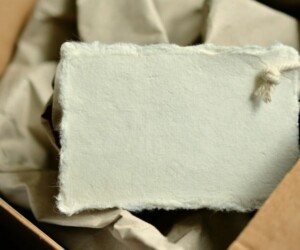
Like paper and cardboard, because the packaging is made from an organic material, it is biodegradable and can be composed at home. It’s always a good idea to double check the labels however, just in case something has been added during the packaging creation process.
When it comes to using bamboo packaging it is increasingly being used to package computing and electronic items that are produced in China and shipped to other countries.
As a local resource bamboo makes a lot of sense to use for packaging. Dell is one such company making use of bamboo packaging for its products.
Is Bamboo More Sustainable Than Plastic?
This is really the million dollar question. If you’re considering buying something made from bamboo it’s probably because you want to reduce how much plastic you use.
Unfortunately it’s not an easy question to answer, and all too often the answer is: it depends.
Let’s consider facts that are clear:
- Bamboo is a highly sustainable natural renewable resource. Plastic isn’t.
- Plastic is killing a lot of wildlife, marine life and polluting a large part of our environment. Bamboo isn’t – or at least it isn’t yet.
- Most bamboo can be composted. But the products that have added chemicals can’t. Plastic can never be composted. Only some plastic can be recycled and this uses large amounts of energy.
- Manufacturing of both plastic and some bamboo products involve nasty chemicals – no one wins here.
Outside of these facts the comparison gets a little more complicated.
It all depends what you’re comparing. A bamboo toothbrush is definitely better than a plastic one if they’ve both been shipped from China.
But a locally made china dinner plate is always going to be more sustainable than a bamboo plate shipped from China. You get bonus points if you buy the china plate second hand 😉
The jury is also out with regards to the durability of bamboo products. While bamboo in its raw form has high strength, when it is manipulated during the production process it becomes a little more fragile.
Reusable bamboo coffee mugs were a keen favourite for a while, but in many cases they simply don’t last as long as their plastic counterparts, especially if someone accidentally sits on them!
Having to replace an item more frequently, especially when air transport is a factor, definitely decreases the overall sustainability rating.
Plastic containers will undoubtedly live in your cupboards for over 10 years if cared for properly. Can we say the same for bamboo containers? Maybe, or maybe not, it’s too early to tell (mould is definitely a concern when exposed to liquids over time).
How Can We Maintain Bamboo Sustainability?
Unprocessed bamboo is a sustainable alternative to timber and steel. We can maintain bamboo’s sustainability by using it for furniture, flooring and utensils.
It’s true that bamboo is very lightweight. Importing it has a smaller carbon footprint than importing heavier materials like wood.
That said, we have sustainable FSC (Forestry Stewardship Council) timber plantations in the UK. Some of which also sell reclaimed or recycled wood.
Before we import ‘eco friendly’ products from the other side of the globe, we should consider going local. Look out for recycled or FSC wood products which have been produced in the UK. Then brush, build or wipe knowing you’re being as sustainable as you can be!
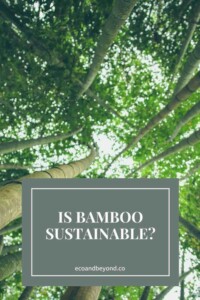
Credit to Author: Brittany Carter
Source: Ecoandbeyond.co

